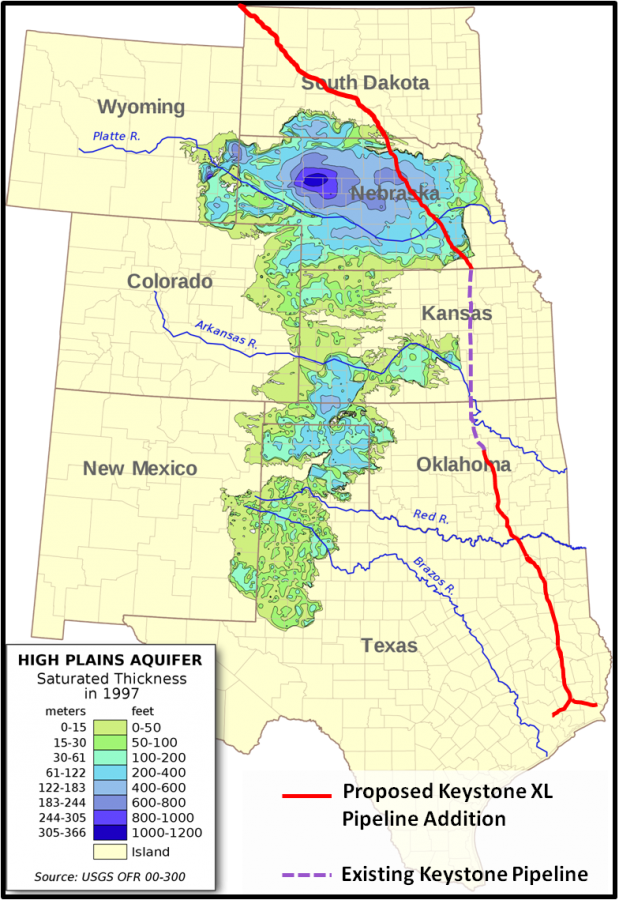The Keystone Quandary
Biden Cancels Pipeline’s Construction Permit
Map showing the Ogallala Aquifer and the planned pipeline.
March 2, 2021
On his first day in office, President Biden recalled the permit of the Keystone Pipeline. Ultimately, cancelling all future operations of the pipeline for the time being. Stated on the Washington Post, this was just 1 out of the “16 executive orders” that were signed that sought to remove the former Trump administration’s changes.
The Keystone Pipeline was a project that was created by TC Energy to send oil sands (a type of oil mixture of sand, water, and clay) nearly 1,200 miles from Alberta, Canada to Nebraska to join an existing pipeline quickly. Each day it would carry 830,000 barrels of oil. Because of that, the pipeline would be able to sell oil into markets at a faster rate.
The development of the pipeline was blocked by the Obama administration back in 2015 due to climate change concerns, but this decision was later overturned by the Trump administration. With the operation being blocked again by the current administration, many of those who advocated for it are worried about the economic consequences for the oil in America.
On CNN Business, Robert McNally, president of Rapidan Energy Group, was an advocate of the economic benefit of the pipeline. McNally said that “diminishing demand for oil won’t keep oil prices low forever…if demand starts peaking soon, supply outside the Middle East will likely fall faster than demand slows.” This would mean that both the price of oil and America’s imports from outside oil sources would increase. With this increase, outside sources–like the Middle East–would decrease their supply and increase their prices to match increased foreign demand.
The International Energy Agency‘s developed scenarios on progressing climate policies on foreseeing oil demands flattening below the “100 mb/d mark, some 4 mb/d.” The agency’s belief is that there will be a “90% of the strong growth in global electricity demand” in renewal energies in the next two decades. So by 2040, it’s predicted that “coal’s share in global energy demand dips below 20% for the first time in modern energy history.”
Despite the agency’s predictions, McNally further explained that “oil’s share of total energy production [will be] falling only eight percentage points over the next 20 years, from 31% to 23% by 2040.” Because of this, consumers would be frustrated over future price booms, which could alarm elected officials and potentially cause them to prioritize economic growth and import dependence.
Many also argued that the Keystone Pipeline would have been beneficial for opening up new jobs. The BBC has estimated that the project would create 28,000 construction jobs. However, these jobs were believed to be temporary rather than permanent. This would mean that once the job was over, these workers would have to find work elsewhere again.
On the other side of the Keystone Pipeline debate are the environmentalists, whose concerns counteract the economic benefit of the pipeline.
One of their major concerns is the increase in carbon emissions that would be associated with the construction of the pipeline. A completed pipeline would encourage energy companies to drill for more oil in Canada. The drilling of more oil, a fossil fuel, would heat up and emit greenhouse gases which would leak out into the atmosphere, exacerbating the greenhouse effect.
The Natural Resources Defense Council (NRDC) stated that “In 2014, the EPA [Environmental Protection Agency] stated that tar sands oil emits 17 percent more carbon than other types of crude”, but was revised three years later to be “5 percent to 20 percent higher than previously indicated.” This meant that the operation had added an additional “178.3 million metric tons of greenhouse gas emissions annually”, which is the equivalent to “38.5 million passenger vehicles or 45.8 coal-fired power plants.”
Another concern for the environmentalists is the risk of oil spills. One of the most recent spills was on October 31, 2019 in Edinburg, North Dakota, which spilled more than 378,000 gallons of oil into wetlands, according to the NRDC. USA Today reported that “drinking water sources were not affected.” However, the oil did spill into “vegetation and soil within the wetlands.”
Those spills have been shown to interfere with the irrigation systems as well. Nebraska’s Ogallala Aquifer, which provides 30 percent of America’s irrigation, was tainted by the aforementioned oil spill and disrupted the distribution of clean water to millions of people. This also devastated the farms and ranches that depended on the clean water for growing their agriculture.
The Keystone Pipeline impacts both the United States and Canada. The BBC reported that Environment Canada found industry chemicals seeping into groundwater and the Athabasca River, in Alberta.
These are fish-bearing waters that the chemicals have polluted. If this continues, the chemicals can seep through the 94 rivers, over 150 named creeks, and 153 lakes that are a part of the Athabasca River system. Not only will this poison the wildlife within the waters, but also both humans and animals who drink it.



